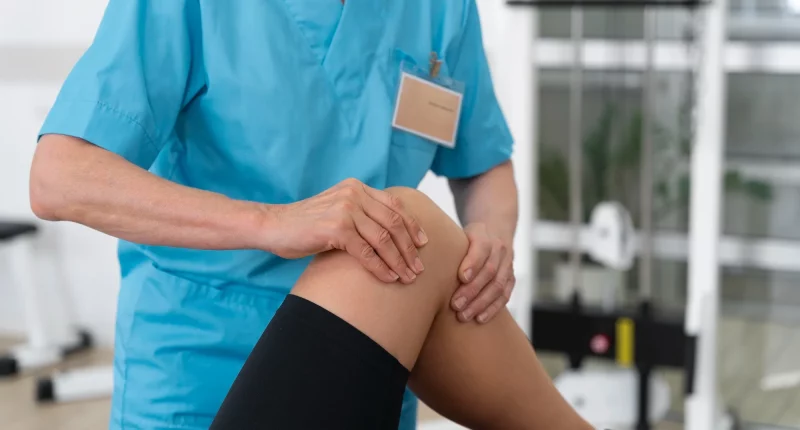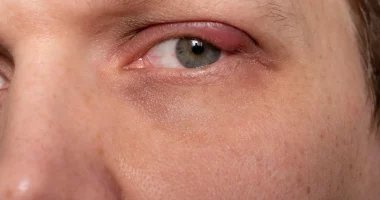A Baker’s cyst, also called a popliteal cyst, a lump that forms behind the knee, in the area known as the popliteal space. It can make the knee feel stiff and painful.
When someone with a Baker’s cyst bends or straightens their knee, or moves around, the pain usually gets worse.
Interestingly, despite its name, a Baker’s cyst isn’t related to baking at all. It was named after Dr. William Morrant Baker, a British doctor who first described and identified this condition in the late 1800s.
What is Baker’s cyst?
A Baker’s cyst, also called a popliteal cyst, a swollen lump filled with a substance that forms at the back of the knee. This occurs when there’s swelling and inflammation in the tissues at the back of the knee joint, often due to conditions like arthritis or gout.
People with a Baker’s cyst might experience stiffness and pain in their knee. They may also notice sounds like clicking, popping, creaking, or feel like the knee is locking up.
Treatment
Home Remedies
Treatment of a Baker’s cyst often begins with self-care and monitoring. Typically, these cysts resolve on their own without needing specific treatment. Home remedies can be effective in managing symptoms. Using ice packs can help decrease inflammation, but it’s important to avoid direct skin contact with ice to prevent damage. Resting the knee is crucial to avoid aggravating the cyst, and healthcare providers may advise on how long rest is necessary and recommend alternative exercises that won’t strain the knee. Crutches can assist in taking weight off the knee joint, making walking less painful. Compression bandages are also beneficial for supporting the knee and can be purchased online.
Medications and Further Treatment
For pain relief and to reduce inflammation, NSAIDs like ibuprofen are commonly recommended. These medications have both pain-reducing and fever-reducing effects. If the cyst persists or is particularly large and painful, additional treatments may be necessary. Corticosteroid injections are often used to directly decrease inflammation and reduce pain, although they do not prevent the cyst from recurring. Physical therapy, supervised by a qualified therapist, may involve gentle exercises to strengthen knee muscles and improve range of motion, which can help manage symptoms and maintain knee function.
In cases where there is significant joint damage or an underlying condition causing the cyst, more invasive treatments such as arthroscopy may be required. During arthroscopy, surgeons use a small fiber-optic tube to inspect and treat issues within the joint, potentially removing the cyst and repairing any damage. It’s worth noting that Baker’s cysts are more common in women, and often associated with conditions like osteoarthritis and rheumatoid arthritis, which are more prevalent in older adults, typically those around 40 years old.
Symptoms and When to Seek Help
The symptoms of a Baker’s cyst can vary, with some people not experiencing any pain or noticing the cyst at all. However, common signs include a noticeable swelling or lump behind the knee, especially when standing and comparing it to the other knee. This inflammation might feel like a water-contained balloon and can be accompanied by calf pain, knee pain, and fluid buildup over the knee. Some individuals may also notice locking, clicking, or buckling sensations in the knee joint.
It’s crucial for anyone experiencing swelling and pain at the end of the knee to consult a doctor. While a Baker’s cyst is a common cause, a bulge behind the knee could also indicate a more serious condition like an aneurysm or tumor. Prompt medical evaluation ensures an accurate diagnosis and appropriate treatment to address the underlying cause and manage symptoms effectively.
Causes
The knee joint relies on synovial fluid to lubricate its cartilage and tendons, ensuring smooth movement and reducing friction during activity. This fluid circulates through small pouches called bursae located over the knee
One of these pouches, the popliteal bursa at the back of the knee, plays a crucial role. It has a valve-like system that controls the flow of synovial fluid between the bursa and the knee joint. If the knee produces an excess of synovial fluid, it can accumulate in the popliteal bursa.
Several underlying conditions can cause this excessive fluid production and lead to the development of a Baker’s cyst. These include inflammatory conditions like gout, where uric acid levels rise and crystals form around joints, causing intense pain and inflammation. Hemophilia, a genetic disorder that prevents blood from clotting properly, and autoimmune diseases like lupus, which prompts the immune system to attack healthy tissues, can also contribute.
Other conditions such as osteoarthritis, characterized by cartilage breakdown in the joints over time, and psoriasis, which can cause joint inflammation, are linked to Baker’s cysts. Additionally, reactive arthritis is a chronic kind of joint inflammation and rheumatoid arthritis is an inflammatory joint disease that is a common culprit. Infections like septic arthritis, where a bacterial infection triggers joint inflammation, and knee injuries like cartilage tears, often seen in athletes, can also result in Baker’s cyst formation. Early medical attention is crucial for diagnosing the underlying cause and managing symptoms effectively.
Diagnosis
Diagnosing a Baker’s cyst typically begins with a thorough patient interview and a physical test of the knee, mainly if there are indications of a basic health issue. The doctor will assess for characteristic signs like swelling and tenderness behind the knee.
In some cases, additional diagnostic examinations are necessary to eliminate more serious conditions like a tumor or aneurysm. Non-invasive imaging tests like ultrasound scans, MRI scans, or CT scans may be ordered. These tests provide detailed images of the knee joint and surrounding tissues, helping the doctor confirm the presence of a Baker’s cyst and assess its size and impact on surrounding structures.
These diagnostic tools play a crucial role in ensuring an accurate diagnosis and guiding appropriate treatment decisions to manage the cyst effectively and address any basic health concerns.
Exercises
Doing gentle exercises can be beneficial for improving or preserving the knee’s range of motion and strengthening the muscles around it. These exercises can also help reduce symptoms and keep the knee working well.
It’s important to consult a healthcare provider or a physical therapist for guidance on which exercises are appropriate. They can recommend exercises that are safe and effective for your specific condition, helping you manage symptoms and maintain the function of your knee.
Complications
The most important risk factor for complications related to Baker’s cyst is active knee issues. Addressing and treating the basic problem often provides the most effective relief. However, in some cases, complications can arise.
One potential complication is the rupture of a Baker’s cyst, which is rare but can occur. When a cyst bursts, synovial fluid leaks into the calf region, leading to several noticeable symptoms. These include sudden and severe pain in the knee, accompanied by significant swelling and possibly redness in the calf area. Some individuals may also feel a sensation of fluid drizzling down the calf.
The body typically reabsorbs the leaked fluid naturally over a time of up to 24 days. During this time, healthcare providers may prescribe painkillers to manage the discomfort. However, redness in the calf region could also indicate another serious condition, such as a blood clot in a vein. Patients experiencing these symptoms should seek immediate medical attention to rule out complications and receive appropriate treatment. Early intervention ensures prompt management and reduces the risk of further complications.
Summary
A Baker’s cyst, also called a popliteal cyst, is a fluid-filled swelling behind the knee caused by excess synovial fluid. Common in those with knee joint issues like arthritis or injury, it can lead to pain, swelling, and restricted movement.
Diagnosis involves physical exams and imaging tests like ultrasound or MRI to confirm the cyst and rule out other conditions. Treatment often starts with rest, ice, and NSAIDs for pain relief. In severe cases, corticosteroid injections or surgery may be necessary. Exercises recommended by a doctor or physical therapist can help manage symptoms and maintain knee function.









